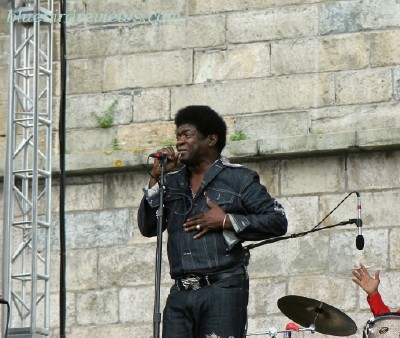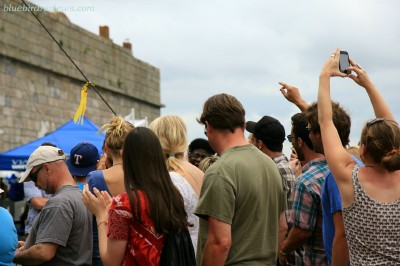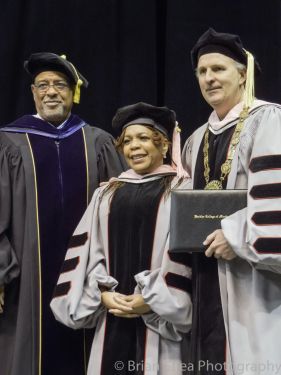People wait in line to hug Charles Bradley.
My first witness of the "Screaming Eagle of Soul" was at the Newport Folk Festival, 2012. No lie, he had the hippie people struttin', and they needed it, after all of that poetic banjo playin'. There are many witnesses to this fantastic, and now globe trotting, artist. BBR writer, Rachel Lange is a huge Buckethead fan. She caught Bradley by chance in DC and said it was the most fun she's ever had at a concert. Regardless of the music genre that you identify with, anyone who's experienced Charles Bradley's James Brown inspired performance, came back with his funky dance, soul pants, groovy love rants, burned into their brain - because he rearranged their neurology.

With the moves of James Brown, the deep vocals of Otis Redding, the smooth lyrical style of Marvin Gaye, and the energy of Barry White, Charles Bradley is sparking hope and enthusiasm for classic soul music to be forefront in the mainstream. I even heard some funkadelic deep cut Temptations, Curtis Mayfield, and Jimmy Castor. Right On! We need artists that can play like this today, outright, without being cast as revivalist 'throwbacks.' Perhaps that's how Charles Bradley started, but with his original work on the airwaves now, we can all move forward to see what's next. I want to hear artists who play soul music, not pop music that's a sprinkle of 'soulful.' And I want an artist who can deliver the all out range of soul. Don't hedge and add a hint of soul here and there, but know the sound so well that you own it. When a true artist owns his inner inspirations, then we get to own ours too. The "Screaming Eagle of Soul" has arrived. He doesn't ride the soul train - He drives it!

Biography:
(From references, NPR music, allmusic.com, thecharlesbradley.com, and the film, Soul of America).
Without even knowing anything about this man, when you see him on stage, you can sense that he has a deep appreciation for life on its terms. There is a film called, Soul of America, (2012). It is a documentary directed by Poull Brien, who first met Bradley when he directed the music video for "The World (Is Going Up In Flames)." In this feature, Charles Bradley's story of heartache and resilience is told:
Mr. Bradley spent his childhood in Florida, raised by his grandmother. At 8 years old, he met his mother for the first time and moved to Brooklyn to live with her. His early inspirations in music were directly from James Brown. In 1962, his sister took him to the Apollo Theatre to see Brown perform. This had the boy dreaming of a better life through music. Mimicking the mannerisms and dancing of Mr. Brown, Charles Bradley quietly developed an identity in soul music at home.
The young teen eventually had to raise himself on the streets of Brooklyn, living in subway cars for two years. He traveled to Maine through Job Corps and worked there as a chef for over a decade. Although far from urban New York, he continued to keep his James Brown image tucked away in his heart. Once a customer told him he looked like Mr. Brown and asked him if he could sing. Bradley didn't admit it at the time, but later started performing with a local band until his mates were drafted into the Vietnam War. Bradley left Maine, hitchhiking across the country landing in upstate New York, Seattle, Canada, and Alaska, before settling in California. He worked several jobs and played small shows for over 20 years.
In 1996, Bradley moved back to Brooklyn because his mother wanted him to get to know her again. He started working exclusively in music then, performing in clubs as a James Brown impersonator called, "Black Velvet." The world, indeed, was "going up in flames," for Charles Bradley during this time, as he became gravely sick after a reaction to penicillin, and his brother was murdered down the road from his mother's home.
He continued to live in Brooklyn, however, and Gabriel Roth, co-founder of Daptone Records, discovered Brown while he was doing his "Black Velvet" gigs. Through Roth, Bradley met Thomas Brenneck, also from Brooklyn, and they did some rehearsing together. Brenneck's band was a funk/soul instrumental ensemble, and Bradley would make up improv lyrics during the rehearsals, which eventually lead to original songs.
In 2002, Daptone started releasing some of these songs on vinyl, until 2011, when Charles Bradley released his debut album, No Time For Dreaming. Bradley's second album, Victim of Love came out on April 2, 2013.

Bradley's backing band is top notch, with full brass and a solid grasp of the widest range of funk, soul, R&B and Motown sounds. Daptone Records has done a great job of bringing out the best in Charles Bradley. His newest release, Victim Of Love, has been on our review turntable for weeks now. We can't get anything done around here, because we keep on dancing. Time to pick up a pen and tell you all about it.

Album Review:
Victim Of Love: Daptone Records/Dunham Records
Release Date: April 2, 2013
Producer: Thomas Brenneck
This record, Victim of Love, is a triumph of hope over heartache, love over hate. Love always wins. Bradley's last album, No Time For Dreaming, was more about struggle and resilience, whereas this newest release celebrates the rise. You can put Victim of Love on your music player, and be sampling the wide range of deep cut soul music that the 1970's have to offer. Echo effects of Motown tones, deep velvet vocals, classic horns and great tempos in every song, make this a prime addition to any music fan's collection.
A hidden gem, is the song, "Confusion". Modeled after early Temptations psychedelics, Bradley nails the authenticity of the funk groove. I say this because we are huge Jimmy Castor fans here on the website. and when I heard that echo vocal reverb on "Confusion," I was thrilled .James Brown is not the only soul that Mr. Bradley has emulated. He is being compared directly to Otis Redding. I think Mr. Castor, only two years gone, would give a "Hey Leroy" shout out to Mr. Bradley. Performing on stages around the country, before he even laid the tracks on his first CD, Charles is not in this to sell records. He's in this for the authenticity of soul roots. This is a journey for us all. And it seems to be just the beginning.
Track By Track:
1. "Strictly Reserved for You," is rhythmic and catchy. With a refrain that doesn't stop, he pours his heart into this romantic swooner. The horns are exact in their glimmering highlights. The psychedelic guitar work is a brief foreshadowing of what's to come further on up the road. Everyone is talking about the fuzz tone guitar and you hear it on various tracks throughout the record.
2. "You Put The Flame on It" is reminiscent of a Four Tops single. It is what joy sounds like. Complete with backing vocals, well placed horns and great harmonies, this song will raise the heat and lift your spirits.
3. "Let Love Stand a Chance" has a simmering groove, much like Barry White, Billy Paul, or Teddy Pendergrass, when radio was good - and the airwaves had soul. He takes his time with this one, repeats a few lyrics with some subtle changes, "Can't let it pass me by, won't let it pass me by ..." keeps the message, while building interest. And that voice, "If YOU walk through that door." It has a deep tone I've heard in other soul music, perhaps that's where the Otis Redding comparison comes in, with a sprinkle of James Brown mixed in, just because that is the DNA of Charles Bradley.
4. "Victim of Love" the title track, opens with a soft and moody acoustic guitar, a gentle background vocals in a do-wop fashion. Bradley comes in bold to admit he has surrendered every thought to the concept of love. "Victim of love, nowhere to hide."
5. "Love Bug Blues."
The recorded version of this song has all of the theatrics of an Issac Hayes track. Flute effects, backups, low down bass tones, brass and even fade out, underline the intensity of Charles' groaning lyrics.
Watch Carl Sanchez, Thomas Brennek on video with Charles Bradley, playing "Love Bug Blues" with just spare instruments. This is a live unplug of the recorded track. What is remarkable, though, is how the song arrangement holds up so well and Charles' voice is right on time, even with improv, because the music is just within him to the degree that everyone in the room can sense it. Great song.
6. "Dusty Blue." Let's talk about the Menahan Street Band.
The Menahan Street Band is a collaboration of musicians from Sharon Jones & the Dap-Kings, El Michels Affair, Antibalas and the Budos Band, brought together by musician/producer Thomas Brenneck (Sharon Jones & the Dap-Kings, Budos Band, Amy Winehouse) to record hits in the bedroom of his Menahan St. apartment in Bushwick, Brooklyn.
This instrumental reflects the integral parts of what is bringing the music together for such an interesting groove. Some of the organ work sounds like water flowing, it is so smooth. The flute and horns give that urban cool vibe which is hard to define, but you know it when you hear it. Drum beats are right on. Steady and true, the Menahan Street Band are the heart of the soul.
7. "Confusion." Some fans have hailed this song to be the best of the record, even though its intention was not to be the highlight. Echo vocals, swirling effects and psychedelic guitar make this a timeless classic already. We love funk master Jimmy Castor here on the website. I still haven't recovered from Mr. Castor's passing, but I'll bet he's got a great "Hey Leroy!" for Mr. Bradley. (Sock it to me!) This track was also compared to deep cuts of the Temptations. Check out Bradley commanding the theramin on this video (timed 3:27). He's got that robot gaze:
8. "Where Do We Go From Here" Fans are saying this song can start up a global revolution - the pain, the power, the soul, the truth. Bradley's voice is controlled and you can hear his stop breaths at the end of certain notes, which stops your own breathing, much the way that James Brown did. The horns are majestic.
9. "Crying in the Chapel." The horns really make this entire record, with the low underscores of the guitar, it's the old school blend of layering bright tones under a strong voice to create the joyful contrast of soul music that we know and love. Much like how Ray Charles and Aretha Franklin switch from soul to blues, Bradley has the ability to bring on the off note. He rambles on in the grit and we just love him for it.
10. "Hurricane." A low tone funk is heard throughout this song. Bradley has a message comparable to Marvin Gaye's "What's Goin On," but its smooth in the delivery like, "I Want You". I wish the bass lines were brought more into the forefront of the production, because they really add to the vintage sound of the track.
11. "Through the Storm." Sam and Dave are not the only men who have great "Thank You" songs. Charles Bradley sings this directly to his fans. With a history of hard life, he seems to appreciate the fragility of it and cherishes every person around him. This gospel influenced meditation is gracious.
We run this website so that we can learn something new from every article we write. Sometimes we learn about a cool new song or an up and coming artist. Other times, a lesson of life is inherent in an article post. If Charles Bradley comes to your town, see him live, take in the shining light of inspiration he has to offer every listener. And give him a hug ... but you'll have to wait in line.

"When the world gives you love," he sings, "It frees your soul." ~Charles Bradley.
PRESS RELEASES:
Most artists appreciate their audiences, just as many are grateful for them, but few artists love their fans as much and as sincerely as Charles Bradley. "I want them to know how much they have helped me grow," notes Bradley when discussing Victim of Love, the follow up to his widely praised debut album No Time For Dreaming. The "Screaming Eagle Of Soul" is set to release the 11-track set April 2 on Daptone Records imprint Dunham Records.
By now, Bradley's remarkable, against-all-odds rise has been well-documented – how he transcended a bleak life on the streets and struggled through a series of ill-fitting jobs – most famously as a James Brown impersonator at Brooklyn clubs – before finally being discovered by Daptone's Gabe Roth. The year following the release of No Time For Dreaming was one triumph after another: a stunning performance at South By Southwest that earned unanimous raves; similarly-gripping appearances at Bonnaroo, Austin City Limits, Newport Folk Festival and Outside Lands (to name just a few); and spots on Year-End Best Lists from Rolling Stone, SPIN, GQ, Paste and more.


